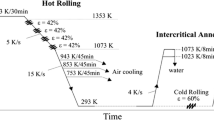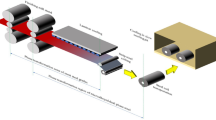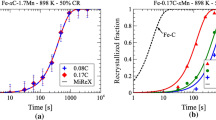Abstract
Because wheel manufacturing requires dual-phase (DP) 590 steel with different thickness specifications, it is necessary to produce DP590 steel with good mechanical property stability through a controlled cooling process. According to the volume fraction of ferrite and martensite and the grain size of ferrite in DP590 steel with different plate thicknesses under industrial production conditions, the effects of strengthening and toughening mechanisms, such as fine grain strengthening and phase transformation strengthening, on mechanical properties are considered, and a prediction model of the microstructure-property relationship of DP590 steel is established. On this basis, the effects of thickness and processing parameters on the grain size and fraction of ferrite are analyzed, which show that the evolution of ferrite accord with physical metallurgy principles. Three DP590 steels are rolled by using the established microstructure-property relationship model, and the results show that the predicted results of the model are in good agreement with the experimental values.









Similar content being viewed by others
Abbreviations
- D :
-
Average austenite grain size at holding time t after coarsening, μm (Eq. 1)
- D 0 :
-
Initial austenite grain size (Eq. 1)
- K 0 :
-
A constant (Eq. 1)
- t :
-
Holding time, s (Eq. 1)
- Q :
-
Activation energy of grain growth (Eq. 1)
- R :
-
The molar gas constant, 8.314 J/(mol·K) (Eq. 1)
- T :
-
Heating absolute temperature, K (Eq. 1)
- ε(i):
-
Equivalent strain of hot-rolled steel plate of ith pass (Eq. 2)
- p :
-
Deformation ratio (Eq. 2)
- h(i):
-
Thickness of hot-rolled steel plate before the ith pass, mm (Eq. 2)
- h(i + 1):
-
Thickness of hot-rolled steel plate after the ith pass, mm (Eq. 2)
- N(i):
-
Rolling speed of the ith pass, m/s (Eq. 3)
- r(i):
-
Roll radius of the ith pass, mm (Eq. 3)
- ε c :
-
Critical strain (Eq. 4)
- ε p :
-
Peak strain (Eq. 4)
- D :
-
Prior austenite grain size, μm (Eq. 4)
- Z :
-
Zener-Hollomen parameter (Eq. 4)
- \(\dot{\upvarepsilon }\) :
-
Strain rate (Eq. 4)
- Q drx :
-
Dynamic recrystallization activation energy (Eq. 4)
- Nb:
-
Niobium concentration in solution in weight percentage for each austenite state (Eq. 4)
- Ti:
-
Titanium concentration in solution in weight percentage for each austenite state (Eq. 4)
- a p :
-
A constant (Eq. 4)
- b p :
-
A constant (Eq. 4)
- X DRX :
-
Fractional softening attributable to dynamic recrystallization (Eq. 5)
- ε :
-
Strain (Eq. 5)
- β :
-
A constant (Eq. 5)
- n DRX :
-
A constant (Eq. 5)
- d DRX :
-
The grain size of dynamically recrystallized austenite, μm (Eq. 6)
- d D G :
-
Dynamically recrystallized grain size where growth occurs (Eq. 7)
- C eq :
-
C Equivalent (Eq. 7)
- [C]:
-
C Concentration in solution in weight percentage for each austenite state (Eq. 7)
- [Mn]:
-
Mn concentration in solution in weight percentage for each austenite state (Eq. 7)
- X S RX :
-
Fractional softening attributable to static recrystallization (Eq. 8)
- \({\mathrm{t}}_{0.5}^{\mathrm{SRX}}\) :
-
Time corresponding to half of the static recrystallized volume (Eq. 8)
- n S RX :
-
A constant, which varies with temperature (Eq. 8)
- d S RX :
-
Statically recrystallized grain size, μm (Eq. 9)
- \({d}_{0}^{i}\) :
-
Prior grain diameter of the ith pass, μm (Eq. 9)
- d SG :
-
Statically recrystallized grain size where growth occurs (Eq. 10)
- ε i :
-
True strain of the ith pass (Eq. 11)
- ε r :
-
Retained strain in the material after leaving the finishing train (Eq. 11)
- ε i − 1 :
-
True strain of the i-1 th pass (Eq. 11)
- T nr :
-
Non-recrystallization temperature (Eq. 12)
- t :
-
Interpass time, s (Eq. 12)
- d N :
-
Non-recrystallized grain size, μm (Eq. 13)
- d avg :
-
Average grain size, μm (Eq. 14)
References
Y. Ding, R. Cao, and Y. Yan, Mater. Sci. Eng. A 773, 138727 (2020).
Y. Liu, B. Gao, M. Yang, L.R. Xiao, J.X. Wang, J.X. Ma, X.J. Chen, H. Zhou, and Y.T. Zhu, Jom-US 92, 1 (2022).
G. Wang, X. Liu, L. Sun, Z. Liu, and D. Liu, Iron Steel 43, 49 (2008).
A. Bag, K.K. Ray, and E.S. Dwarakadasa, Metall. Mater. Trans. A 30, 1193 (1999).
A.P. Pierman, O. Bouaziz, T. Pardoen, P.J. Jacques, and L. Brassart, Acta Mater. 73, 298 (2014).
E. Evin, J. Kepič, K. Buriková, and M. Tomáš, Metals-Basel 8, 242 (2018).
G. Toktas, A. Toktas, and A.D. Karaoglan, J. Iron Steel Res. Int. 21, 715 (2014).
M. Alibeyki, H. Mirzadeh, M. Najafi, and A. Kalhor, J. Mater. Eng. Perform. 26, 2683 (2017).
C. Li, and B. Sun, J. Univ. Sci. Technol. Liaoning 31, 575 (2008).
A. Laasraou, and J.J. Jonas, ISIJ Int. 31, 95 (1991).
F.H. Samuel, Mater. Sci. Eng. A 142, 95 (1991).
X. Huo, K. He, J. Xia, L. Li, and S. Chen, J. Iron Steel Res. Int. 28, 335 (2021).
P. Wang, X. Zhou, and D. Wu, J. Mater. Met. 5, 57 (2006).
D. Dong, F. Chen, and Z. Cui, J. Mater. Eng. Perform. 25, 152 (2015).
A.I. Fernández, P. Uranga, B. López, and J.M. Rodriguez-Ibabe, Mater. Sci. Eng. A 361, 367 (2003).
Z. Li, X. Zhou, J. Wang, and D. Wu, Special steel 26, 27 (2005).
S.F. Medina, and J.E. Mancilla, ISIJ Int. 33, 1257 (1993).
X. Zhou, (Northeastern University: Shenyang, 2007), pp 53.
P.D. Hodgson, and R.K. Gibbs, ISIJ Int. 32, 1329 (1992).
R.A. Ramos, Phys. Rev. B 59, 9053 (1999).
S. Phadke, P. Pauskar, and R. Shivpuri, J. Mater. Process. Tech. 150, 107 (2004).
M. Hillert, Acta Metall. 13, 227 (1965).
Y.J. Lan, D.Z. Li, X.C. Sha, and Y.Y. Li, Steel Res. Int. 75, 462 (2004).
J.I. Soliman, and E.A. Fakhroo, J. Mech. Eng. Sci. 14, 19 (1972).
N. Peng, J. Luo, and N. Peng, Metal. Mater. Met. Eng. 44, 3 (2016).
S. Serajzadeh, Appl. Math. Model. 27, 861 (2003).
Acknowledgements
The authors would like to acknowledge the financial support from the Ministry of Science and Technology, China (No. 2022YFB3304800), the project from Liaoning Province (No. XLYC1902034) and directional items of Liaoning National Science and Technology Award (2022JH25/10200001), the Postdoctoral Science Foundation of China (2022T150205), the Postdoctoral Research Fund for Northeastern University (20210203) and the National Natural Science Foundation of China (52104370).
Author information
Authors and Affiliations
Corresponding authors
Ethics declarations
Conflict of interest
The authors declare no conflict of interest.
Additional information
Publisher's Note
Springer Nature remains neutral with regard to jurisdictional claims in published maps and institutional affiliations.
Supplementary Information
Below is the link to the electronic supplementary material.
Rights and permissions
Springer Nature or its licensor (e.g. a society or other partner) holds exclusive rights to this article under a publishing agreement with the author(s) or other rightsholder(s); author self-archiving of the accepted manuscript version of this article is solely governed by the terms of such publishing agreement and applicable law.
About this article
Cite this article
Li, X., Zhou, X., Jiang, Q. et al. The Prediction of the Mechanical Properties for Hot-Rolled Nb Micro-Alloyed Dual-Phase Steel Based on Microstructure Characteristics. JOM 75, 2225–2234 (2023). https://doi.org/10.1007/s11837-023-05795-6
Received:
Accepted:
Published:
Issue Date:
DOI: https://doi.org/10.1007/s11837-023-05795-6




